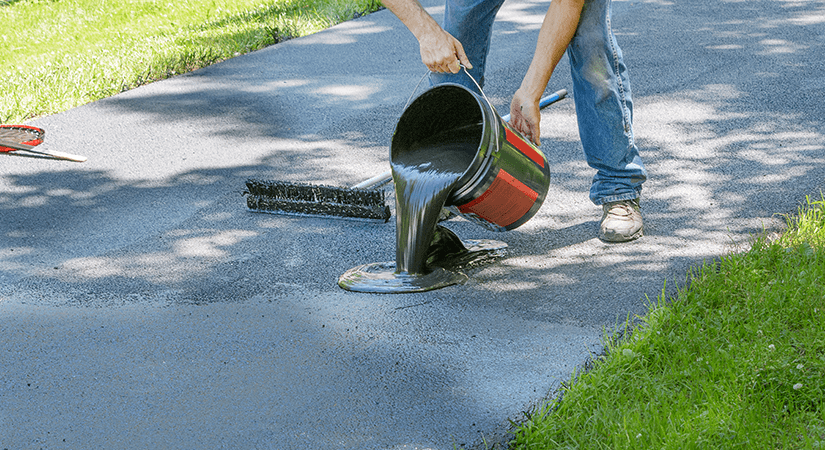Renew Your Property with Regrading and Asphalt Sealing Strategies
Renew Your Property with Regrading and Asphalt Sealing Strategies
Blog Article
Warm Mix Asphalt: A Sustainable Service for Pavement
Warm Mix Asphalt (HMA) has emerged as a leading sustainable selection for sidewalk remedies, providing a myriad of cutting-edge technologies and ecological advantages. As the need for eco-friendly construction methods expands, checking out the nuances of HMA's sustainability can offer valuable insights into the future of pavement services.
Ecological Advantages of Warm Mix Asphalt

In Addition, Hot Mix Asphalt helps to minimize metropolitan warmth island impacts. Its dark shade takes in sunlight, reducing the amount of warm mirrored back right into the ambience contrasted to lighter-colored sidewalks. This can lower ambient temperature levels in city areas, decreasing the demand for a/c and eventually lowering energy intake.
On top of that, Hot Mix Asphalt adds to boosted stormwater administration. Its porous nature enables water to infiltrate the sidewalk and recharge groundwater materials, reducing runoff and the risk of flooding. These environmental benefits make Warm Mix Asphalt a lasting option for leading highways and roadways.
Power Efficiency in HMA Production
Is power effectiveness a critical element in the manufacturing of Warm Mix Asphalt (HMA)? Power plays a substantial role in the production of HMA, affecting both expense and ecological sustainability. One crucial facet of power performance in HMA production is the use of cozy mix asphalt (WMA) modern technologies.
Moreover, innovations in plant technologies have caused even more energy-efficient HMA manufacturing procedures. Modern plants are developed with functions like recycled asphalt pavement (RAP) handling capabilities, efficient burner systems, and improved insulation, all adding to energy cost savings. By enhancing energy usage in HMA production, the market can lower its carbon footprint while maintaining premium pavement materials. Energy performance is, consequently, a vital factor to consider in making certain the sustainability of Hot Mix Asphalt manufacturing.
Recyclability of Warm Mix Asphalt
The recyclability of Hot Mix Asphalt (HMA) is an essential element of its sustainability and long-lasting environmental effect. HMA is just one of the most recycled materials in the USA, with over 100 million bunches of recovered asphalt sidewalk (RAP) being reused each year in brand-new pavement building and construction. Recycling HMA supplies a number of ecological benefits, such as reducing the demand for virgin materials, reducing energy consumption during production, and decreasing the amount of waste sent out to land fills.
The process of recycling HMA involves grating the existing sidewalk, squashing it into smaller sized items, and blending it with new aggregate and asphalt binder to create a recycled mix. In general, the recyclability of HMA plays a substantial duty in advertising lasting practices within the sidewalk industry.

Long-Term Efficiency of HMA
Asphalt pavements demonstrate toughness and strength try this web-site over a prolonged period, reflecting the long-lasting performance of Hot Mix Asphalt (HMA) The longevity of HMA can be credited to its capacity to stand up to rush hour loads, harsh weather, and the effects of aging. Studies have actually revealed that properly designed and properly created HMA sidewalks can last for two decades or more with normal maintenance. The trick to making the most of the lasting efficiency of HMA depends on utilizing high-grade products, adhering to finest techniques in building and construction, and executing reliable upkeep approaches. Correct drainage, regular inspections, and prompt repairs are crucial for preserving the structural honesty of HMA sidewalks over time. Additionally, innovations in HMA modern technology, such as using polymer-modified binders and cozy mix asphalt, have actually better boosted the durability and long life of HMA pavements. By prioritizing high quality construction and maintenance practices, HMA continues to verify itself as a economical and lasting remedy for lasting sidewalk facilities.

HMA: Toughness and Sustainability
Demonstrating both longevity and sustainability, Hot Mix Asphalt (HMA) has actually come to be a foundation in the building and construction of lasting sidewalk frameworks - angled parking. HMA's longevity comes from its capability to stand up to hefty lots, severe weather, and high traffic volumes, making it a trusted option for roads, highways, and flight terminal runways. The composition of HMA, which typically includes accumulations, binder, and filler, plays an important duty my response in boosting its long life and resistance to damage
Furthermore, HMA's sustainability depends on its recyclability and energy-efficient production procedure. The ability to recycle recovered asphalt pavement (RAP) in new HMA mixtures reduces the need for virgin materials and minimizes the ecological impact of pavement building and construction and maintenance. Furthermore, the energy performance of creating HMA exists in its lower mixing temperature levels contrasted to various other pavement products, bring about reduced power consumption and greenhouse gas discharges.
Final Thought
In conclusion, warm mix asphalt (HMA) provides a sustainable service for sidewalk with its ecologically pleasant qualities. HMA's recyclability, power performance in production, and long-term resilience make it an environment-friendly selection for road building.
HMA is one of the most recycled materials in the United States, with over 100 million heaps of redeemed asphalt pavement (RAP) being recycled each year in new pavement building.The process of recycling HMA involves milling the existing sidewalk, crushing it into smaller sized pieces, and blending it with brand-new aggregate and asphalt binder to create a recycled mix.Asphalt pavements show toughness and durability over an extensive duration, reflecting the long-term efficiency of Hot Mix Asphalt (HMA) Additionally, improvements article in HMA technology, such as the usage of polymer-modified binders and cozy mix asphalt, have additionally boosted the toughness and durability of HMA sidewalks. The capability to recycle recovered asphalt sidewalk (RAP) in new HMA mixtures reduces the demand for virgin products and reduces the ecological effect of pavement building and construction and upkeep.
Report this page